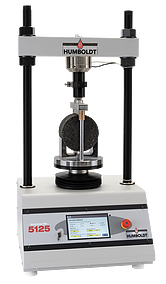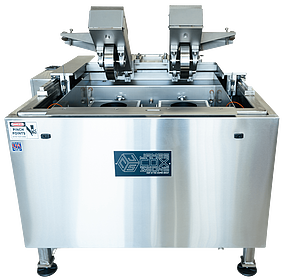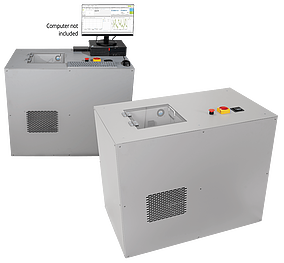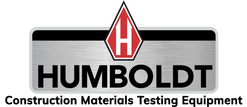
HM-5125A.3F
Load Frame, Balanced Mix, Automated
This load frame is Designed to provide precise test rate control for the automated testing of balanced mix samples.

HA-5300A.4F
Hamburg (Immersion) Wheel Trackers
Best performing Hamburg machine that complies with the AASHTO T324 spec.

HM-2480.4F
Humboldt Overlay Tester, 220V 50/60Hz
The New Humboldt Overlay Test is a dedicated cyclic-cracking system engineered specifically for the Overlay Test
Balanced Mix Design
In 2015, the Federal Highway Administration (FHWA) Expert Task Group (ETG) Balanced Mix Design Task Force defined balance mix design (BMD) as an “asphalt mix design using performance tests on appropriately conditioned specimens that address multiple modes of distress taking into consideration mix aging, traffic, climate and location within the pavement structure”. Essentially, balanced mix design involves designing a mix that is specific to the intended application, through the incorporation of multiple mechanical tests, which are designed to examine particular forms of distress.
Many highway agencies are actively working towards the implementation of a balanced mix design (BMD) procedure to improve the field cracking performance and durability of their pavements. BMD is an asphalt mixture design process that uses performance tests on appropriately conditioned specimens to address primary modes of distress while taking into consideration asphalt mixture aging, traffic, climate, and location of the mixture within the pavement structure. Most BMD approaches use performance index tests to balance asphalt pavement rutting performance with durability/cracking performance. Typical index tests for rutting include Hamburg Wheel Track Test (HWTT), Asphalt Pavement Analyzer test (APA) or the High Temperature Indirect Tensile Strength test (HT IDT). The two most common cracking index tests are the Illinois Flexibility Index Test (FI or I-FIT) and the Indirect Tensile Cracking test (CT index). Implementation efforts are ongoing to develop a standard suite of index tests and standard criteria.
Recently, professors have begun to investigate cracking tests for the evaluation of asphalt mix designs. These tests include the Louisiana SCB, the Illinois Flexibility Index, the Texas Overlay test and the IDEAL CT test. These cracking tests can be divided into two groups: Dynamic, which includes Bending Fatigue and Texas Overlay, and Monotonic, which includes Bending Fatigue, Louisiana SCB, I-FIT, IDEAL CT, and DCT.
The success of these tests has seen the emergence of Balanced Mix Design. As Balanced Mix Design and the cracking tests are relatively new, there is some nervousness at the idea of transitioning directly to this new approach. Furthermore, there are three general approaches towards the introduction of Balanced Mix Design.
The Automated, Balanced-Mix Load Frame:
Humboldt’s HM-5125A load frame has been designed to provide precise, test-rate control for the automated testing of balanced mix samples. This control is provided by a Closed-Loop Feedback Control of the speed function, which ensures highly-accurate results.
Tests that can be run with this load frame are:
TSR — AASHTO T283
I-FIT (SCB IL Method) — AASHTO TP124
SCB (LSU Method) — ASTM D8044
IDEAL-CT (TTI Method) — ASTM D8225
IDEAL-RT (TTI Method) — ASTM D8360-22
ISS (Interlayer Shear Strength) — AASHTO TP114
Marshall — ASTM D6927, AASHTO T245
Hveem — ASTM D1560
The easy-to-operate, HM-5125A load frame alws you to quickly choose your test and its parameters in the Test Setup Wizard for automated operation of the testing process and results. Humboldt’s HM-5125A.3F is the ideal load frame for use when testing balanced mix design samples. Balanced mix design involves using a variety of cracking tests, which are used to simulate different types of loading conditions on a test sample. The HM-5125A.3F is designed to easily and efficiently provide precise test-rate control for the automated testing of balanced mix samples. The benefits and features of Humboldt’s HM-5125.3F load frame establish it as the perfect load frame to use when testing balanced mix design samples. Its unique versatility and excellent quality make it the most highly-regarded option in its field.
Hamburg (Immersion) Wheel Trackers
The HA-5300A.4F Hamburg test, or immersion wheel tracking, has become an extremely popular test method over the last few years. The Hamburg wheel tracker is built to withstand the demands of the busiest test labs. It is made of high-quality stainless steel, uses the standard cantilevered arm system of loading the specimen,s and produces fully sinusoidal motion. In the NCHRP report - Hamburg Wheel-Track Test Equipment Requirements and Improvements to AASHTO T 324, the Cox/Cooper Hamburg was clearly the best performing machine. Since then, the heaters and water flow have been upgraded, resulting in more rapid heating and improved temperature. A number of Hamburg wheel trackers do not correctly meet current AASHTO requirements and may fall further behind when the norm is updated. The Cox/Cooper machine meets all the requirements of the standards.
The New Humboldt Overlay Tester
The New HM-2480.4F, Humboldt Overlay Test Machine is an advanced cyclic-cracking system engineered for precise, repeatable Overlay Testing of asphalt mixtures. Designed to eliminate common issues found in traditional overlay testers, it features an ultra-stiff frame, integrated displacement measurement, and a patented platen system that ensures secure specimen loading without high-torque clamping. Ideal for predicting cracking performance in modern asphalt mixes, this servo-hydraulic unit offers research-grade accuracy, low compliance, and optional high-resolution imaging to track crack propagation in real time. With precision temperature control, intuitive software, and full compliance with TxDOT Tex-248-F and the proposed ASTM Overlay standard, the Humboldt Overlay Test delivers unmatched reliability for pavement engineers, researchers, and materials labs seeking next-generation performance testing.
Asphalt Tack Bond Shear Strength Apparatus
The HA-1343 Asphalt Tack Bond Shear Strength Apparatus is used in a Marshall Stability Test Load Frame to measure shear strength of tack coat material between two asphalt layers. The heavy steel frame holds fixed and movable shear plates. The movable plate is centered over the shear plane and features roller bearings to minimize drag. Lateral load on the specimen is controlled by a calibrated spring, and a dial indicator displays force. The shear plane gap is 0.5" (12.5mm), and the maximum shear travel is also 0.5" (12.5 mm). Adapters are included for testing either 4" (102mm) or 6" (152mm) diameter samples. The Tack Bond Shear Strength Apparatus is compatible with Marshall Load Frames with daylight openings of at least 10" (254mm). The HA-1343 Asphalt Tack Bond Shear Strength Apparatus tests 4" (102mm) and 6" (152mm) Marshall samples. The HA-1343M Asphalt Tack Bond Shear Strength Apparatus accommodates testing of 100mm and 150mm Marshall specimens.
For more information about Balance Mix Design Click Here.

